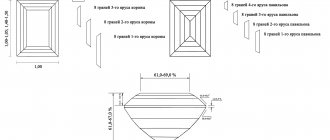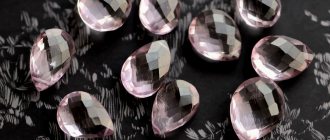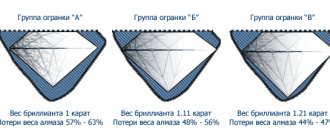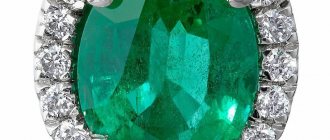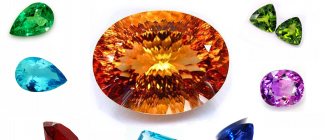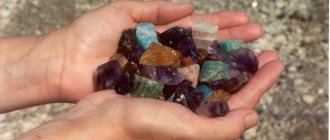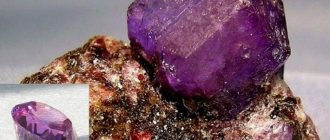For many people, what makes being a diamond cutter attractive is a special touch of mystery and romance. After all, the transformation of a not particularly attractive mineral into an amazingly beautiful stone is somewhat similar to magic. At the same time, few people know that behind all this magic and romance are hidden not at all easy working conditions, which we will also talk about today.
Diamond is a unique mineral that has always occupied a special place in the life of mankind. In ancient times, magical properties were attributed to it, and the largest specimens were surrounded by mystical legends. Today, few people believe in the supernatural abilities of a diamond, but they are happy to use it as a symbol of success and prosperity.
Let’s say right away that although rough diamonds attract attention with their unusual shape (and each diamond is unique), they absolutely do not amaze the imagination with their beauty and luxury. And all because the usual shine of diamonds, which splashes with a billion multi-colored reflections at the slightest contact with a ray of light, this crystal acquires only after it has been in the hands of a cutter.
Well, if we take into account the fact that more than 35 million carats of diamonds are mined annually in the Russian Federation alone, and cut stones (that is, diamonds) have always been, are, and will most likely be in high demand, you can guess: diamond cutters have never will remain without work, and true masters of their craft will be constantly in demand on the labor market.
This profession also has a special touch of mystery and romance that makes it even more attractive. After all, the transformation of a not particularly attractive mineral into an amazingly beautiful stone is somewhat similar to magic. At the same time, few people know that behind all this magic and romance are hidden not at all easy working conditions, which we will also talk about today.
What is a diamond cutter?
A diamond cutter is a highly qualified specialist who processes (grinds and polishes) diamonds to eliminate the natural defects of the mineral and give it a certain shape that allows the stone to retain its mass and, at the same time, maximize its brilliance and play of color.
The name of the profession comes from the Proto-Slavic gran (one who makes edges) and the ancient Greek ἀδάμας (adamas - diamond - indestructible). The first mention of the profession of “diamond cutter” dates back to 1465. It was then that the Burgundian jeweler Ludwig Berkem first cut a diamond in the shape of a “rose” (today this type of cut is used extremely rarely). It is not known exactly when Russian jewelers learned to process diamonds. But it can be assumed that the history of the diamond cutting profession in Russia began simultaneously with the discovery of the first deposit of this mineral - in 1829. Cutting factories in our country began to appear only after the discovery of diamond deposits in Yakutia in 1954.
Today, there are 7 large cutting factories in Russia, and Russian diamonds are valued all over the world. And all thanks to the fact that domestic diamond cutting masters are true professionals in their field, whose responsibilities, in addition to direct processing of the mineral, include:
- determination of characteristics and parameters of rough diamonds and finished products;
- elimination of natural stone defects;
- the use of cutting techniques that increase the yield of finished products;
- recutting during diamond restoration;
- determination of the type and technological sequence of cutting;
- determination of cut quality;
- the difference between diamonds and synthetic analogues and imitations.
Let's sum it up
Thanks to the information we presented in this article, each of you could take something useful for yourself. Since this profession, although known to many, few people are aware of such subtleties as:
- what does an organist do?
- what personality traits should he have:
- what are the pros and cons of this type of activity;
- how to become an organist and where to get training.
We gave a detailed description of all this in the sections of our article.
Now you know the answer to the question: “who is this cutter?”
What personal qualities should a diamond cutter have?
The incomparable “play” of a diamond is achieved through facets arranged in a certain way through which light passes. The number of facets can vary from 17 to 102, which, taking into account the small size of the crystals, suggests that a diamond cutter must have impeccable vision. In addition, it is impossible to achieve professional success in stone processing without such personal qualities as:
- good artistic taste;
- ability to perform precise, small-amplitude movements;
- observation;
- patience;
- perseverance;
- responsibility;
- accuracy;
- creativity;
- stress resistance;
- a penchant for manual labor.
In addition, a stone cutting specialist must not only know the basic crystallographic forms of diamonds and the optical properties of this mineral, but also love the stone with all his soul, feel and “understand” it, and also carry out the cutting both according to a jewelry model and according to drawings of varying complexity .
Requirements for the personal qualities of a specialist
Needless to say, such an unusual and at the same time complex profession requires special people.
CALL A LAWYER
HE WILL SOLVE YOUR QUESTIONS FOR FREE Moscow, region 8 (499) 577-00-25 ext. 130 St. Petersburg, region 8 (812) 425-66-30 ext. 130 Federal number 8 (800) 350-84-13 ext. 130
Namely, those who have the following qualities:
- He is attracted to monotonous manual labor;
- He has excellent artistic taste and has creative inclinations;
- Takes responsible work seriously and understands its importance;
- Has high resistance to stress and is not subject to sudden mood swings;
- Knows how to organize his working time as efficiently as possible.
Benefits of being a diamond cutter
Today Russia ranks second in the world ranking of countries where the bulk of all diamonds are mined. According to various estimates, our country will have enough resources in this area for at least another 30-40 years. Therefore, it is not difficult to guess that in the next few decades, cutting specialists will be guaranteed to be provided with work (that is, in demand).
Another advantage of being a diamond cutter is the absence of boredom. Despite a certain monotony of work, stone cutters consider the cutting process very interesting and exciting. After all, it depends only on their skill whether an inconspicuous mineral, similar to a piece of glass or quartz, will turn into a luxurious diamond that can decorate any piece of jewelry with its radiance.
The salary of cutters also deserves attention - according to various sources, the average monthly salary of a specialist in cutting precious stones is about 30-40 thousand rubles. But here it is necessary to immediately clarify that Russian diamond cutting enterprises are reluctant to disclose such information. Therefore, the data given here is only approximate.
And most importantly, there is an aura of romanticism and mystery that surrounds representatives of this profession. On the one hand, these are the most ordinary people, most of them of average income, and on the other hand, thousands of dollars “pass” through the hands of each of the cutters every day. Agree, few people have to hold real diamonds in their hands every day, which every girl dreams of.
Amethyst stone
Amethyst is a purple quartz of various shades and color saturation. “The name that this stone bears is said to come from its peculiar color, which approaches the color of dark red wine,” wrote Pliny the Elder.
Properties of the stone
Chemical formula: SiO2
Mohs hardness: 7
Density: 2.63 - 2.65 g/cm3
Gloss: glassy, pearlescent
Refractive index: 1,543 — 1,554
Color: violet to pale reddish-violet
Syngony: trigonal
Cleavage: none
Amethyst changes color depending on the lighting. For example, under artificial light, Ural specimens become brighter and acquire a violet-red hue, while Brazilian amethysts under the same lighting acquire a gray tone.
The property of some stones to change their color under the influence of different lighting or when rotated is called pleochroism .
When heated too much, amethyst loses its color. When the temperature rises to 250°, it first becomes yellow, then greenish and finally colorless. If you heat the stone to 470 - 750 °C, you will get a specimen of light yellow, red-brown or rich green color. You can return the original color to the stone using x-rays.
Thus, using heat and irradiation, it is possible to create other varieties of quartz from amethyst.
Amethyst as a variety of quartz
Quartz is a whole group of minerals that differ from each other in color and appearance, but have the same chemical composition. Amethyst is a variety of quartz of purple and lilac color with various undertones - red, brown, orange. Amethyst is mined in the Urals (Russia), the USA, Brazil, Japan, Zambia, Namibia and Sri Lanka.
Colorless quartz is otherwise called “rock crystal”, yellow quartz is citrine, black is morion, green is prasiolite, pink is rose quartz. And these are just a few varieties of quartz, there are 22 in total - they all differ in color, type of inclusions, pattern shape and transparency.
Amethyst stands apart in the list of different types of quartz, because its color cannot be confused with anything else; it is a unique mineral that almost every person recognizes. It lies in the depths of the Earth in the form of druses - stones of various shapes growing from a common base. Most often these forms are prismatic, but scepter-shaped ones are also found.
Stones from the private collection of the founder of the jewelry house Maxim Demidov are part of the exhibition of many museums in Russia and the world. For example, the Ural Geological Museum displays amethysts found by Maxim Demidov during his student years. Flagship brand stores also have several exhibits in the form of amethyst druses and geodes. It is fair to say that Maxim Demidov is one of the largest stone collectors in the country.
Examples of the Maxim Demidov collection
There are two unusual types of amethyst:
- “hairy” amethyst - it contains hematite in the form of thin crystalline plates or needle-shaped inclusions of goethite;
- ametrine - amethyst with an admixture of citrine.
If we talk about other types of stone, jewelry, then there are at least two of them:
- saturated Siberian (Deep Siberian) - a stone of rich color with bright purple and bright red tints that cannot be faked or recreated in an artificial stone, this is the most expensive amethyst, which is mined in the Urals, South America, Sri Lanka and Africa;
- Rose of France (Rose de France) is a stone of light lilac color with a pinkish tint, not very thick and bright, but quite common in many countries.
History of amethyst
There is a version that the name of the mineral is associated with a myth: the nymph Ametis was in love with a shepherd, but the god of wine Dionysus was fascinated by her. Fleeing from him, the beauty took refuge in the temple of Artemis, the patroness of all living things. To prevent the nymph from falling to Dionysus, Artemis turned her into a statue. The angry god poured wine on Amethys, but the statue absorbed the drink and acquired an incredible purple color. When Dionysus could not bring his beloved back to life, he split the statue - this is how purple crystals called amethyst appeared.
This stone has been known to man since the times of Ancient Egypt and antiquity. The ancient Romans revered amethyst as a helper in difficult situations and as a stone that brings good luck. In the Middle Ages, amethyst was a favorite stone of clergy, and in the 17th century it was known and loved in Rus', calling purple stones “dumplings.”
The beauty of amethyst evokes admiration and curiosity. This mineral attracts all lovers of jewelry, esotericists, lithotherapists and astrologers with its magical color.
Properties and Application
Amethyst is used by lithotherapists in the treatment of various diseases, it is valued by mystics and loved by astrologers, it is bought, given as a gift and carefully stored, because this stone is a real secret. You can comprehend it through long contemplation of the violet glow of the nugget.
Medicinal properties
It has long been believed that amethyst can save a person from infections, and modern lithotherapists say that contact with the purple stone relieves nervous tension and saves from overload and insomnia. Also, specialists in stone treatment are confident that the water in which amethysts lie improves blood circulation and saturates the brain with oxygen. The main thing is to regularly energetically clean the stones under running water in order to wash away the accumulated negativity from them.
Amethyst also helps in the fight against addictions, especially addiction to alcohol. Eliminates cravings for smoking and overeating. In Rus' they believed that amethyst promotes rejuvenation and improves facial skin, removes rashes. The healing properties of the stone cope with migraines, infertility, and gout.
Amethyst earrings have a positive effect on mental health. Wearing the stone gives spiritual strength and relieves anxiety. If you put amethyst under your pillow at night, it will relieve nightmares and restless sleep. But you should not abuse the influence of this stone - an excess of such energy can distract a person too much from all problems and make him indifferent to worldly life.
Magic properties
The magical properties of amethyst are that it can act as an amulet and talisman, and is also an invisible assistant to philosophers, poets, artists and all people who strive to comprehend the truth.
The color violet is considered mystical in itself; it is a conductor between the world visible and invisible to the human eye. The color of amethyst has a hypnotizing effect and helps to comprehend the secrets of the universe through unexpected discoveries given in the stream of violet glow.
Amethyst is a stone that greatly influences relationships between people. In Ancient Babylon, it was considered the key to discovering new romantic adventures and an assistant in getting rid of old love pangs. Due to this belief, amethyst is not recommended as a gift to married women. However, amethyst has another strong magical property - it can evoke love in the one who gives this stone, even if the person receiving the gift is already in love with someone.
Who is suitable according to their zodiac sign?
Astrologers believe that amethyst is an excellent option for the signs of the air elements: Libra, Aquarius, Gemini. Due to its relationship to the element of air, amethyst will have a positive effect on those who are too busy with earthly concerns and forget about the spiritual.
For representatives of fire signs, amethyst is useful in that it will pacify their temper, anger, and their characteristic impatience. This is especially true for Aries - they need amethyst during periods of increased irritability.
Application area
Amethyst is most widely used in jewelry; it adorned the regalia of rulers, for example, the crown of Irina Godunova, a Russian ruler of the late 16th century.
Amethyst can be called the mineral of priests. The tradition was born from imitation of the Apostle Paul, who had a ring with this stone. Among Catholics, young cardinals and bishops receive an amethyst ring; such items are often worn by holy fathers.
In the Orthodox Church, amethyst is also loved because the stone symbolizes harmony and peace of mind, protecting the mind from vicious thoughts.
Artificial amethyst
Artificial amethysts are usually completely transparent and clear, making them look like violet glass. Natural stones contain natural impurities of various metals and organic compounds, which can be seen if you hold the amethyst to the light. Although there are natural specimens of exceptional quality, in which there are practically no inclusions, they do not leave behind the feeling that you were holding “glass” in your hands, as is the case with artificial stones.
For the first time, artificial amethysts were obtained at the Lebedev Physical Institute of the Academy of Sciences (FIAN) in Moscow, where chemists were able to grow crystals 20-30 cm in size. Today, the market for artificial stones is constantly growing, so their prices are falling. But natural stones are always more expensive - they are unique in their kind and their supply in the world is limited.
How to wear and care for amethyst jewelry
Esotericists recommend wearing rings with amethyst on the middle finger of the hand, which is the finger of Saturn, so the positive energy of the stone is most activated.
Amethyst looks great in combination with cool colors, so against the background of clothes in similar colors, amethyst will look especially advantageous. But it is not recommended to wear bright acid colors with a purple stone.
Amethyst jewelry requires special care and storage. These stones are quite strong, but still vulnerable, so you should protect them from falls, impacts and direct sunlight. It is better to store jewelry away from heating systems, in rooms with moderate humidity and temperature. It is also worth avoiding contact of amethyst with other stones - harder minerals can damage amethyst and leave unsightly marks.
If you want to learn more about the rules for caring for jewelry with colored stones, you can read our article Caring for jewelry with semi-precious stones.
You will find jewelry with amethysts of exceptional quality in the Maxim Demidov catalog.
Disadvantages of being a diamond cutter
The disadvantages of being a diamond cutter are primarily of a medical nature. Firstly, constant eye strain leads to vision problems. Secondly, sedentary work very often causes diseases such as osteochondrosis, varicose veins, hemorrhoids, chronic fatigue syndrome, heart disease, etc.
Disadvantages also include the increased level of safety at gem cutting plants. Not every person can calmly accept the fact that when leaving work they are literally scanned through and through for the presence of illegally smuggled diamonds.
In the professional activities of cutters, very unpleasant situations also occur, for which they then have to pay for many years. For example, one master said that a finished diamond somehow fell out of his hands, the cost of which was deducted from his salary for five whole years (until the diamond was found). True, after the stone was found, all the money withheld was honestly returned to him. They are also punished with rubles if, through the fault of a specialist, the crystal was irreparably damaged.
Medicinal properties
Amethyst is a healing stone known since ancient times. People believed that they could avoid intoxication by keeping a rock crystal in a glass of wine. In Ancient Greece, stone violet was a means of rejuvenation. The mineral got rid of pigmentation, freckles, and wrinkles. The Slavs believed that the Bacchus stone protects from bad thoughts and depression, makes a person kinder, protects a warrior in battle, helps to catch a wild bird, and neutralizes poisons. They believed that a stone placed in the bed would protect against temptation.
Lithotherapists use the bishop's stone to treat skin diseases and headaches - to do this, simply apply a copy to the disturbing part of the body. In rock lithotherapy:
- strengthen memory;
- take control of emotions;
- cultivate dispassion;
- stabilize the nervous system;
- treat insomnia.
Amethyst is used in lithotherapy
A drink prepared with the mineral is useful for inflammation, fever, and colds. It cleanses the liver, kidneys, blood vessels. Amethyst amulets are worn during an epidemic to protect against infection. Earrings with such cabochons are good for vision.
Jewelry with Bacchus stone improves brain function, activates blood flow, and protects against nervous breakdowns. To enhance immunity, wear an amethyst ring. Lithotherapists recommend the breed for getting rid of gout, osteochondrosis, and alleviating the course of mental disorders. The mineral will help with nervous overexcitation and improve the quality of rest.
Stone violet helps treat alcohol addiction. It is necessary to drink an amethyst infusion and constantly wear a necklace with a cabochon so that it is at the level of the solar plexus. The stone will help if the patient himself is interested in the result.
The best result is observed with constant contact of the stone and skin. Usage:
- external (instances are applied to problem areas);
- internal (use water infused with the rock).
Wash with infusion. Massage with crystals is useful. For greater effect, they are combined with crystal, which concentrates energy and directs it to a person. Amethyst amulets are regularly cleansed of accumulated negativity.
Princess
The princess cut is a “pumped up” version of a square with at least 16 edges, and they can be located both from the center and from the edges of the outer contour. Its highlight is the mirror symmetry of the corners, which can create a cross-shaped or star-shaped reflection. There are practical advantages - no matter how complex the master jeweler’s idea may be, the specific arrangement of the facets can significantly save the amount of stone removed.
Interesting fact: It was the princess that formed the basis of the most commercially successful Tiffany cut, which since the middle of the last century has become the international standard for engagement rings. According to the American brand, a diamond in such jewelry must have at least 50 facets that can shimmer at the slightest movement of a woman’s hand.
Circle
It is ironic that the most sought-after cut on the market, the perfect circle, is one of the most difficult to execute, since it was originally invented for diamonds, which until around the 16th century remained minimally processed in earrings or rings. Today, the “royal standard” is considered to be a circle façade of 57 facets, regardless of the weight of the gem, although smaller exceptions are possible for very tiny stones.
Square
A fairly ancient technique that has become popular due to its simplicity and natural grace of parallel lines. To be completely precise, the crystal turns out to be square only in the main section - in fact, it is a truncated pyramid. For such an insert to look respectable, blanks weighing 1 carat or more are required, which is why the form has become most popular with semi-precious gems.
Pear
It is also a drop, which arose as a development of the round style. Jewelers joke that the pear-shaped cut appeared as a result of a million damaged blanks in the form of a circle. It is distinguished by harmonious central symmetry and beveled facets in the form of wedges. Thanks to this combination, even a tiny insert will have a shine that will be the envy of massive crystals, and in pendants, pendants or long earrings it looks especially elegant and rich.
Trillion
The youngest method of processing natural gems has not even celebrated its 40th anniversary - it was patented by an Amsterdam jewelry house in the mid-80s. As you might guess, the prefix three- in the word trillion means the texture of a triangle, along which the edges are alternately applied. They can be equilateral or isosceles, the main thing is to ensure the refraction of light and disintegration into that same priceless rainbow spectrum.
Oval
With the advancement of technology and the advent of electric machines in the mid-20th century, the improved oval cut was born. She didn't just add a wedge-shaped fin surface that maximizes light refraction from the surface of the crystal. Thanks to the elongated texture, precious rings with such an insert visually lengthen the fingers, and pendants or earrings are so impressive that they are guaranteed to attract all the attention.
